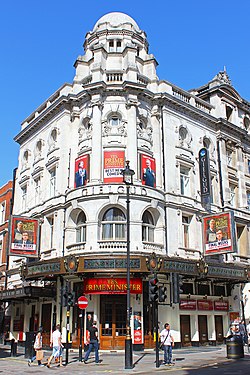
Back مسرح جيلجود ARZ Gielgud Theatre German Teatro Gielgud Spanish تئاتر گیلگود Persian Gielgud Theatre Italian Gielgud Theatre Polish 吉尔古德剧院 Chinese
 Gielgud Theatre in 2011 | |
 | |
| Address | Shaftesbury Avenue London, W1 United Kingdom |
|---|---|
| Coordinates | 51°30′42″N 00°07′59″W / 51.51167°N 0.13306°W |
| Public transit | |
| Owner | Delfont Mackintosh Theatres |
| Designation | Grade II[1] |
| Type | West End theatre |
| Capacity | 994 on three levels |
| Production | Juno and the Paycock |
| Construction | |
| Opened | 27 December 1906 |
| Architect | W. G. R. Sprague |
| Website | |
| www | |
The Gielgud Theatre is a West End theatre, located on Shaftesbury Avenue, at the corner of Rupert Street, in the City of Westminster, London. The house currently has 994 seats on three levels.
The theatre was designed by W. G. R. Sprague and opened on 27 December 1906 as the Hicks Theatre, named after Seymour Hicks, for whom it was built. The first play at the theatre was a hit musical called The Beauty of Bath co-written by Hicks. Another big success was A Waltz Dream in 1908. In 1909, the American impresario Charles Frohman became manager of the theatre and renamed the house the Globe Theatre, a name that it retained for 85 years. Call It a Day opened in 1935 and ran for 509 performances, a long run for the slow inter-war years. There's a Girl in My Soup, opening in 1966, ran for almost three years, a record for the theatre that was not surpassed until Daisy Pulls It Off opened in April 1983 to run for 1,180 performances.
Refurbished in 1987, the theatre has since presented several Alan Ayckbourn premieres, including Man of the Moment (1990), as well as a notable revival of An Ideal Husband in 1992. During reconstruction of Shakespeare's Globe theatre on the South Bank, in 1994 the theatre was renamed the Gielgud Theatre in honour of Sir John Gielgud. Another refurbishment was completed in 2008.
The Globe's theatre cat, Beerbohm, became famous enough to receive a front-page obituary in the theatrical publication The Stage in 1995.
- ^ Historic England (28 June 1972). "Gielgud Theatre (1236174)". National Heritage List for England. Retrieved 9 October 2014.